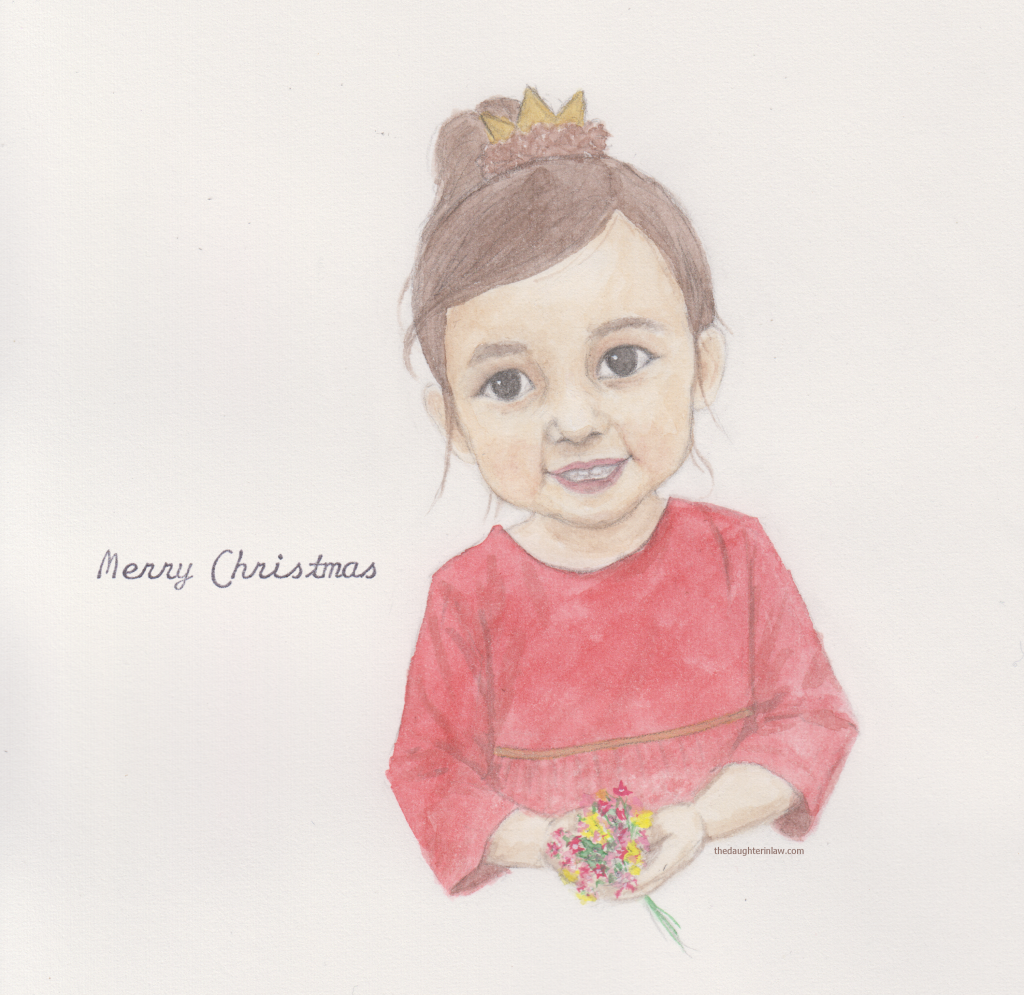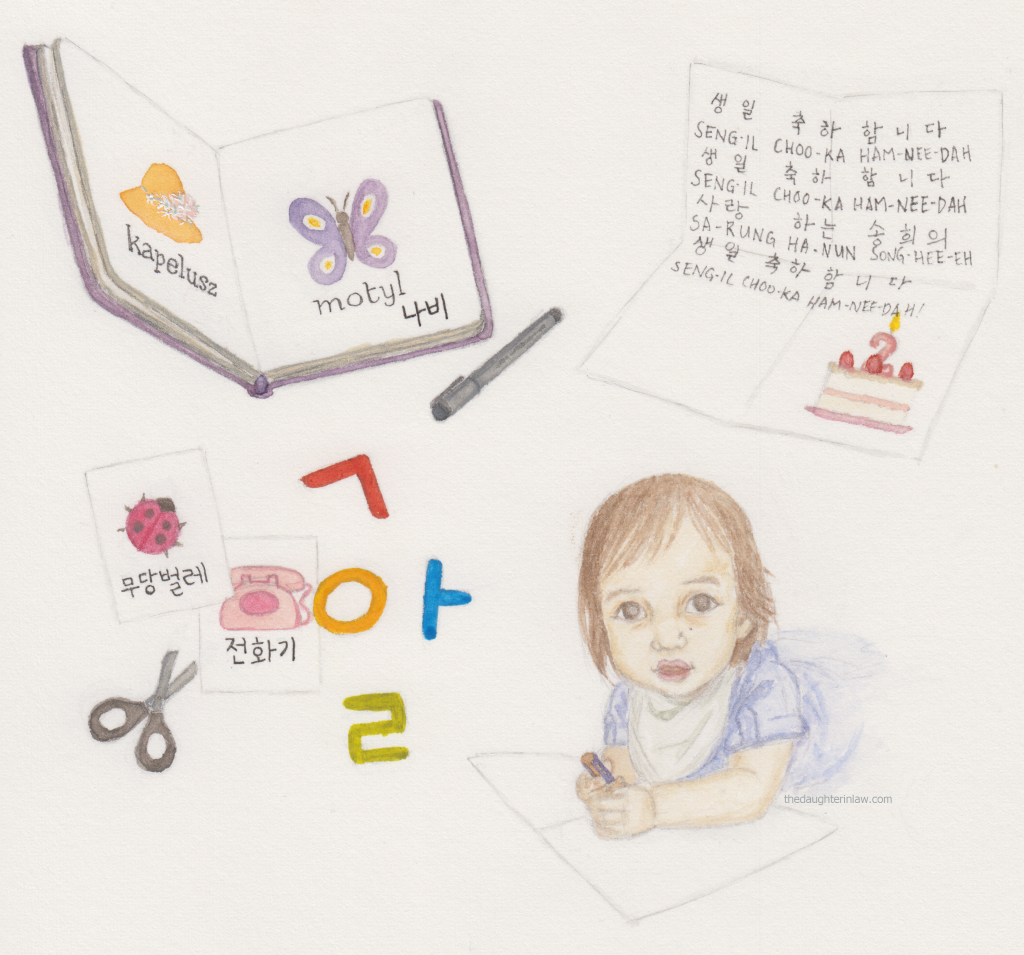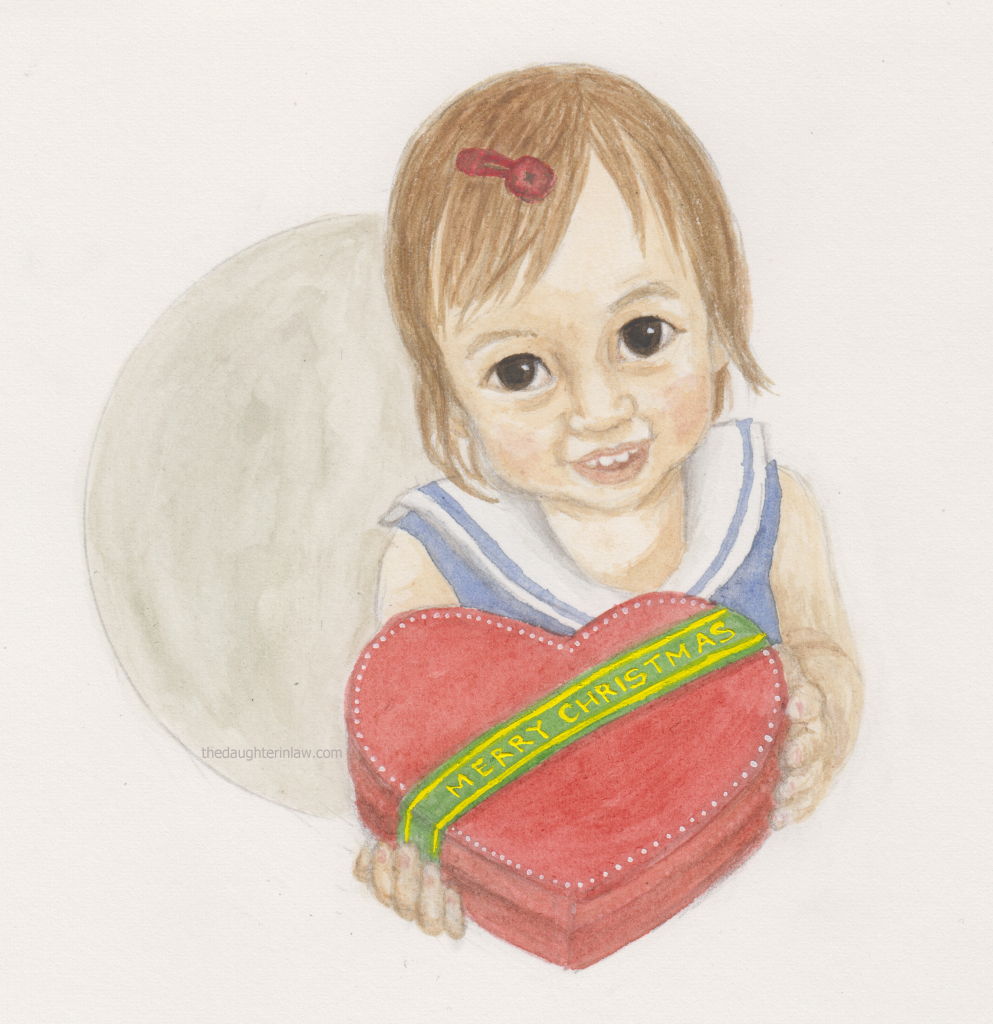When Han and I first came to Korea together before getting married, I got a job at a 24 hour cafe that was situated between the officetel where we lived, and a restaurant (drinking and nightlife) street. Working at that cafe helped me build confidence at speaking Korean, and also gave me a unique opportunity to indulge in people watching from the counter. We had many fascinating regular and random customers, and I made a lot of sketches and little comics at the time. Today I thought I would share one, just for the sake of doing something different and feeling nostalgic about my younger self.
Posts Categorized: Uncategorized
메리크리스마스!

Home made resources
 This year we made the decision to move to one of the suburbs of Sydney which has a well established Korean community. It’s an important element of my bilingual strategy for Alice, and has already proven to be worthwhile, with Alice and I building positive relationships with local shops and cafes that can serve us using Korean language, reinforcing it as a useful and meaningful language to Alice. There are some things we still wish for, like a Korean preschool or primary school (there is such a school for the local Japanese community, but not Korean, as it seems that most Korean people here are more concerned about their children’s English skills) Our new neighbourhood is very different from our last, which was predominantly Caucasian. I am aware that not everyone will have the desire to move, the luxury of access to a Korean community, to inlaws or the ability to travel readily. Still, I’d encourage you to rethink what you have around you to work with, and here I’m going to discuss some simple ways you can create some of your own Korean language resources to use at home.
This year we made the decision to move to one of the suburbs of Sydney which has a well established Korean community. It’s an important element of my bilingual strategy for Alice, and has already proven to be worthwhile, with Alice and I building positive relationships with local shops and cafes that can serve us using Korean language, reinforcing it as a useful and meaningful language to Alice. There are some things we still wish for, like a Korean preschool or primary school (there is such a school for the local Japanese community, but not Korean, as it seems that most Korean people here are more concerned about their children’s English skills) Our new neighbourhood is very different from our last, which was predominantly Caucasian. I am aware that not everyone will have the desire to move, the luxury of access to a Korean community, to inlaws or the ability to travel readily. Still, I’d encourage you to rethink what you have around you to work with, and here I’m going to discuss some simple ways you can create some of your own Korean language resources to use at home.
Board Books:
Toddlers love books, but those bulky first board books are heavy and usually don’t have a huge amount of content per book, so it is not really economical to spend too much money on buying them in Korean language. If your local library stocks books in Korean, borrow what you can. You can buy some board books in your own language and simply write the Korean translations in with a permanent marker, or stick in label stickers. You might even want to put in some post-its with prompts for questions you can ask your child as you read, or appropriate comments or sound effects, to make your reading time that bit more special and personal, even if you aren’t confident ad-libbing. Once your child reaches a certain age however, these labels are likely to be pulled out, so use them as prompts to get you up to speed as soon as possible, then take them out once you are confident.
한글 놀이:
Type out the 한글 characters on your computer, increase the font size, print and use them as templates to cut out felt or cardboard characters in bright colours. You can use these with a felt board, or some adhesive magnets on the fridge or blu-tak to teach a slightly older child early literacy skills. Alice is already starting to recognise the appearance of her name at age 2, so pointing at words as you read, and reading aloud as you write things out is never a waste of your time.
Flash Cards and Posters:
Make some personalised flash cards with photos, simple drawings or pictures from magazines. Start with words and objects that your child is familiar with, as there is much excitement and reward in being able to recognise something and name it easily. You can add in new pictures and words after or ahead of special events or new experiences, or simply as your child’s world expands and they see new things. This also reinforces your own memory, if you are learning new vocabulary with your child.
You could also label or relabel posters or large pictures with things like parts of the body or members of the family and display these in the child’s room or wherever you play together.
Another idea might be to make flash cards of things you regularly buy at the grocery store. You could punch a hole in each card, then, when you go shopping, put the cards that represent your shopping list on a ring together, and your child can help you find all the items on the ‘list’
Share Songs with Family:
Transliterate favourite songs for family members so they can also share things that are dear to your child. My mum made a big poster with a transliteration of the Birthday song to take to our big family lunch in Sydney for Alice’s 2nd birthday. Anyone who follows me on Instagram might remember how obsessed she has been with this song and the idea of birthdays since our trip to Korea earlier this year. When we held up the poster, the whole family was instantly able to sing Happy Birthday to Alice, in her language. Her eyes were sparkling with excitement. Your transliterations do not need to be written using the RR or McCune-Reischauer systems. Use whatever spelling will help the people close to you use as accurate pronounciation as possible. (I’ve found people not familiar with Korean tend to be confused by written sounds like ‘eo’ for ‘어,’ but if you say the word or sing the song aloud and just write it as you hear it, it should be close enough.
Please feel free to share your own ideas in the comments section of this post.
Storytelling
Having a baby causes you to revisit your own childhood. Memories, years buried, suddenly resurface. Somewhere, from deep within comes a longing to relive the experiences, and to share tales of games once played and toys once adored. I’ve recently been particularly nostalgic for the dolls of my girlhood, searching for photos and information about them online and then letting all the memories rush back, smiling.
My mother has always been a reader and I have so many wonderful memories of reading with her, and just enjoying the beauty of the illustrations in my beloved books. Naturally, I’d always assumed I’d one day read these same books to my own children, so from time to time I have brought some old favourites back to my place after visiting mum.
Of course I grew up in a different time, in different circumstances. In a small town with little exposure to other multicultural society. My mother has always been open minded, accepting of all people and all cultures. Yet as I am now a mother to a bicultural baby, I reread my childhood books with the perspective and sensitivity of our family’s circumstances, and from time to time I am jarred by the racism to be found in their pages. Again, I want to be clear, my mum is not racist, and if she reread these books now she would be as shocked as I.
The other day I opened one such book, it was a Little Golden Book from 1972 with particularly charming illustrations by Sharon Kane, I read through quietly to myself and smiled as I came across a page where three babies were pictured in a basket.. and then I read the rhyme underneath it which described them each in racial colour terms and explained how there wasn’t really enough room in the basket for all three of them. I was really disappointed.
The next morning, Alice was playing with Han and decided she wanted to hear a story. Han invited her to go fetch a book and wouldn’t you know, she picked the Little Golden Book. In my head I lamented that she hadn’t picked a Korean language book (We are still only using Korean with Alice and have so far only exposed her to books in Korean)
Without missing a beat, Han opened the cover of the book and started making up a short story for each page, in Korean. When he turned to the three babies who couldn’t fit in the basket, suddenly they were transformed into three babies having a lovely time playing together in that same basket. That’s the lovely thing about being married, particularly to someone of a different mother tongue and big imagination- having someone there to take the evil out of your once treasured books and recreate them into the future fond memories of your children. Maybe one day we’ll type up our own new poem to glue in, under that picture of three babies in a basket.
Merry Christmas!


